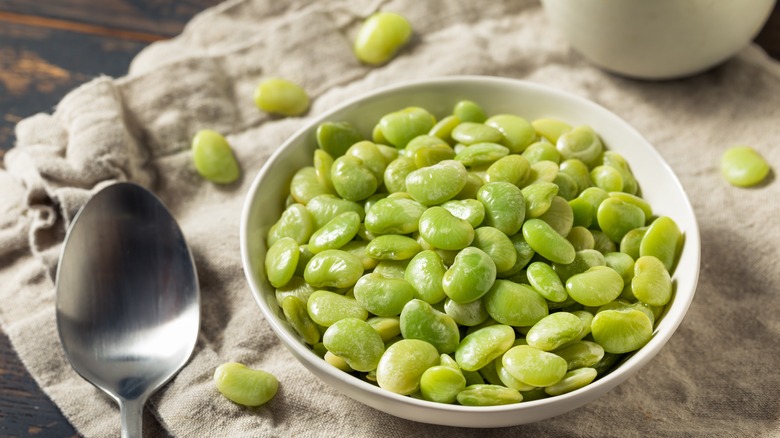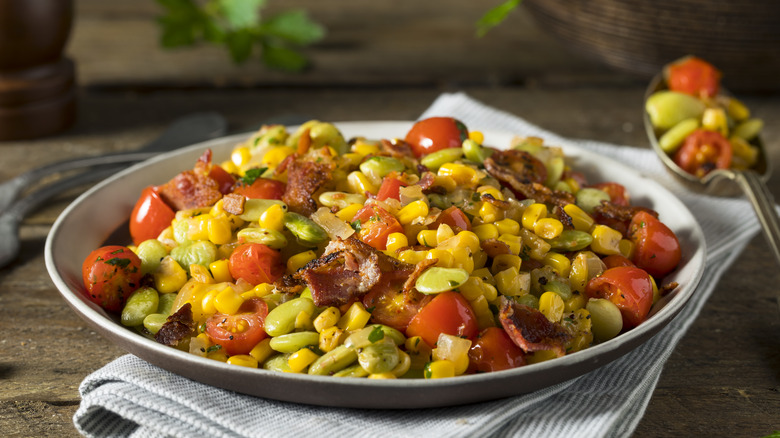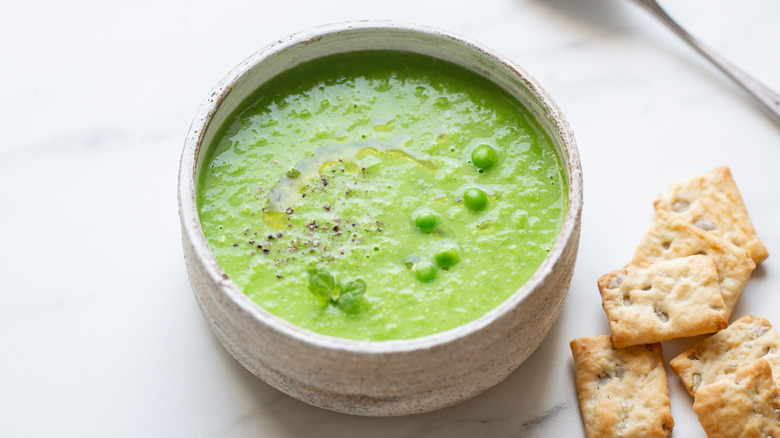The Closest Substitute For Peas In A Recipe
Peas belong to the Fabaceae family of plants, which encompasses over 20,000 species of beans, legumes, and peas. Their leafy relatives, such as lentils and chickpeas, are generally characterized by muted colors, firm textures, and mild, earthy flavors, facilitating their interchangeable use in culinary applications. However, peas have a unique personality all their own. They provide a burst of color and, when bitten into, pleasantly pop in the mouth, releasing an explosion of sweetness. If you find yourself unable to procure peas for a particular recipe, identifying an appropriate substitute can be challenging. However, one underappreciated legume stands out: lima beans.
Lima beans are named after Peru's capital, near where the Mayan and Aztec peoples first cultivated them. Nowadays, they are grown and consumed globally. Despite their large, flat, and curvy appearance, which contrasts with the spherical and petite peas, lima beans perfectly match peas in two crucial aspects: taste and texture. In fact, depending on the region, lima beans are sometimes referred to as butter beans — a nickname that stems from their creamy and sweet qualities, making them an excellent substitute for peas.
Tips for using lima beans in place of peas
When substituting lima beans for peas in a recipe, you can typically use a one-to-one ratio. However, it's crucial to carefully calculate the weight or volume based on the beans' processing state. Beans are available fresh (either in their pods or shelled), dried, canned, or frozen, and the recipe should specify which form is required. If your recipe calls for frozen peas and you only have dried or canned lima beans, it's manageable, but may necessitate additional steps like draining, drying, or cooking the beans before continuing with the recipe.
A significant distinction between the two is that while peas can be consumed raw, lima beans must be cooked. Lima beans contain a compound called linamarin, which can convert to cyanide when ingested, potentially causing health issues such as nausea, vomiting, dizziness, chest pain, and headaches, as noted by the Centers for Disease Control and Prevention. Boiling or steaming lima beans for just five to 10 minutes can neutralize the enzymes that release cyanide, rendering them safe for consumption.
Other pea replacements
There's a whole world of beans to know and cook out there, but if you're in a pinch and lima beans aren't available, your best alternatives are fava beans, edamame, or black-eyed peas. Like peas and lima beans, all of these legumes are similarly packed with protein, fiber, and micronutrients such as iron, folate, magnesium, and thiamine. They can all also be used in a diverse array of recipes for any season, from comforting casseroles and soups to light bean salads and pesto for pasta.
As with lima beans, you should avoid eating edamame and black-eyed peas raw, since these high-fiber legumes can cause stomach pain due to digestive issues (according to Healthline). They are best suited for cooked dishes, such as stew or succotash, where their firm texture offers a pleasant contrast to softer ingredients like tomatoes and corn. Fava beans are the ideal swap for dishes that call for raw peas, such as pureed spreads for toasts or springtime salads, where their green color and crisp consistency can shine.
When making substitutions, be aware that in cases where peas are the star ingredient, as with pea soup, opting for another type of bean will more significantly impact the overall taste and texture of the dish. Given that the other legumes are not as sweet as peas, you might consider adding a drizzle of honey or agave syrup to some recipes to account for this difference.



